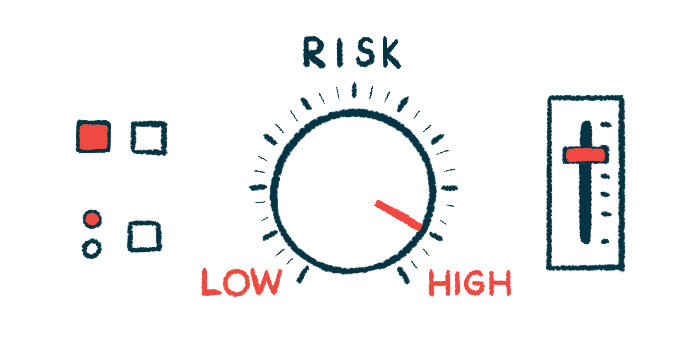Older age, higher steroid dose raise risk of death due to infection in AAV
Patients over 65 with DAH at more pronounced risk, study showed
Written by |

Older age and higher glucocorticoid exposure are significantly associated with a higher risk of death due to infections among people with ANCA-associated vasculitis (AAV), a study showed.
Patients older than 65 were more likely to die from complications of life-threatening infections, which can result from using immunosuppressive therapies to control disease activity. This increased risk was particularly pronounced among patients with diffuse alveolar hemorrhage (DAH), a severe lung bleeding complication that often requires intensified treatment with higher glucocorticoid doses.
“Given the heightened susceptibility of older AAV patients to the adverse effects of immunosuppressive therapy, it is of paramount importance to tread a delicate balance between disease control and the prevention of serious infectious complications in this patient population,” the researchers wrote.
The study, “ANCA-associated vasculitis and the impact of diffuse alveolar hemorrhage in elderly patients: a retrospective cohort study,” was published in Rheumatology International.
Higher mortality rates seen in AAV patients over 65
AAV is a group of autoimmune diseases marked by inflammation and damage to small blood vessels, which can affect nearly any organ but most frequently involves the lungs and kidneys. The frequency of AAV rises with age, making it predominantly a disease of older adults, with the highest rates observed in people aged 60 years and older.
Treatment often involves glucocorticoids, a type of steroid, and other immunosuppressive therapies that have improved remission and survival rates for many patients. However, they carry significant risks, most notably severe infections, which are more common in older patients.
DAH, marked by lung bleeding caused by damage to the small blood vessels that supply the air sacs where gases are exchanged, is one of the most severe pulmonary complications that can arise in AAV. It often requires aggressive treatment that further heightens infection risk.
However, “in elderly AAV patients with DAH the available data on treatment, outcomes, and complications are still very limited,” the authors wrote.
… it is of paramount importance to tread a delicate balance between disease control and the prevention of serious infectious complications in this patient population.
With this in mind, researchers retrospectively analyzed data from 139 newly diagnosed AAV patients who were followed for five years at the University of Heidelberg, in Germany, between 2004 and 2023.
More than half (55%) had granulomatosis with polyangiitis, while 45% had microscopic polyangiitis, the two most common types of AAV.
Patients were divided into two groups: those 65 or younger and those older than 65. Both groups showed similar disease activity, but the older patients had significantly worse kidney function.
The older group was further divided into those with and without DAH. Those with DAH had more severe disease at diagnosis.
Regarding immunosuppressive treatment, most of the younger and older patients were initially treated with cyclophosphamide and high-dose oral glucocorticoids, or steroid pulse therapy.
Overall, older patients were given lower doses of either treatment at disease onset. However, by three months, steroid doses were similar.
Although older and younger patients responded similarly to treatment, older patients had a much higher risk of dying during the follow-up period. By the study’s end, 24% of the older patients had died, compared with 9% of the younger patients.
Infections were a major cause of death among the older group, affecting 14% of patients, compared with 3% of younger patients. Pneumonia, a lung infection, was the most common infection, often caused by opportunistic microbes that rarely cause disease in healthy individuals but can lead to severe illness in those with weakened immune systems.
75% of deaths in older DAH patients caused by infection
When specifically looking at patients older than 65, those with DAH received higher doses of oral steroids compared with those without DAH: 60 vs. 40 mg at disease onset and 20 vs. 12 mg after three months of treatment. By six and 12 months after onset, oral steroid doses were comparable between the two groups.
Additionally, a significantly higher proportion of patients in the DAH group received steroid pulse therapy (100% vs. 77%) and plasma exchange therapy, a blood-cleaning procedure used to remove AAV-causing antibodies (44% vs. 10%).
Despite similar rates of disease remission and relapse, older patients with DAH had a 44% mortality rate, which was significantly higher than in the group without DAH (17%). This was primarily due to infections, which led to the deaths of one-third of the former group and 8% of the latter.
Notably, six out of eight deaths in older DAH patients were caused by complications of severe infections, “especially pneumonia during the first 6-12 months,” the researchers wrote.
Pneumonia was the most frequent fatal infection, affecting 61% of older patients with DAH and 29% of those without the complication. Sepsis, a severe body-wide response to infection, was also more common in the DAH group, with 33% of patients affected. Among the non-DAH group, 8% experienced sepsis.
In contrast, younger AAV patients with DAH did not show a significantly increased mortality rate from infections, despite higher infection rates.
When accounting for multiple variables, only older age at diagnosis and higher glucocorticoid dose at three months were identified as independent predictors of death due to infectious complications. DAH was not an independent risk factor for such death.
“We showed that life-threatening infectious complications with opportunistic pneumonia are common in elderly AAV patients with DAH during the first year after disease onset and higher [glucocorticoids] doses during maintenance therapy were an independent predictor of death from infectious complications,” the researchers wrote. “Therefore, rapid [glucocorticoids] tapering should be carefully re-evaluated to balance the risk between infection and disease progression in this high-risk population.”







